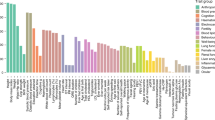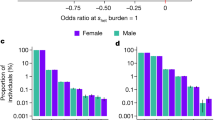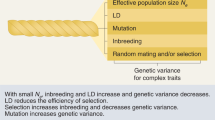Abstract
An analysis of the world literature on the children of first cousin marriages reveals that the depression of survival in offspring followed from birth (including late miscarriages; at about six months gestation or later) to a median age of 10 years is constant (4.4% ± 4.6) across a wide range of values for population prereproductive mortality. There is thus no evidence for the action of conditional lethals. On the basis of these data, it is calculated that the average human is heterozygous for only 1.4 lethal equivalents capable of acting over this portion of the life cycle. The implications of these results are discussed in the context of genetic counseling, and the biomedical significance of variation in DNA.
This is a preview of subscription content, access via your institution
Access options
Subscribe to this journal
Receive 12 print issues and online access
$209.00 per year
only $17.42 per issue
Buy this article
- Purchase on Springer Link
- Instant access to full article PDF
Prices may be subject to local taxes which are calculated during checkout
Similar content being viewed by others
References
Basu, S.K. Effects of consanguinity among Muslim groups of India. Medical Genetics in India, vol 2 (ed. Verfna, I.C.) 173–187 (Auroma, Pondfcherry, 1978).
Rao, P.S.S. & Inbaraj, S.G. Inbreeding effects on human reproduction in Tamil Nadu of South India. Ann. hum. Genet. 41, 87–98 (1977).
Rao, P.S.S. & Inbaraj, S.G. Trends in human reproductive wastage in relation to long-term practice of inbreeding. Ann. hum. Genet. 42, 401–413 (1979).
Bittles, A.H., Shami, S.A. & Appaji Rao, N. Consanguineous marriage in Southern Asia: Incidence, causes and effects Minority Populations: Genetics, Demography and Health (etis Bittles, A.H. & Roberts, D.F.) 102–118 (MacMillan, London, 1992).
Shami, S.A. & Study of consanguineous marriages in the population of Lahore (Punjab), Pakistan. Biologia 28, 1–15 (1982).
Shami, S.A. & Iqbal, I. Consanguineous marriages in the population of Sheikhupura (Punjab), Pakistan. Biologia 29, 231–244 (1983).
Shami, S.A. & Hussain, S.B. Consanguinity in the population of Gujrat (Punjab), Pakistan. Biologia 30, 93–109 (1984).
Shami, S.A. & Minnas, I.B. Effects of consanguineous marriages on offspring mortality in the City of Jhelum (Punjab), Pakistan. Biologia 30, 153–165 (1984).
Shami, S.A. & Siddiqui, H. The effects of parental consanguinity in Rawalpindi City (Punjab), Pakistan. Biologia. 30, 189–200 (1984).
Bittles, A.H., Grant, J.C. & Shami, S.A. An evaluation of consanguinity as a determinant of reproductive behaviour and mortality in Pakistan. Int. J. Epidemiol. 22, 463–467 (1993).
Schull, W.J. Empirical risks in consanguineous marriages: Sex ratio, malformation, and viability. Am. J. hum. Genet. 10, 294–343 (1958).
Neel, J.V. & Schull, W.J. The effect of inbreeding on mortality and morbidity in two Japanese cities. Proc. natn. Acad. Sci. U.S.A. 48, 573–582 (1962).
Yamaguchi, M., Yanase, T., Nagano, H.N. Effects of inbreeding on mortality in Fukuoka population. Am. J. hum. Genet. 22, 145–159 (1970).
Schull, W.J., Nagano, H., Yamamoto, M. & Komatsu, I. The effects of parental consanguinity and inbreeding in Hirado, Japan I. Stillbirths and prereproductive mortality. Am. J. hum. Genet. 22, 239–262 (1970).
Komai, T. & Tanaka, K. Genetic studies on inbreeding in some Japanese populations. II. The study of school children in Shizuoka: History, frequencies of consanguineous marriages and their subtypes, and comparibility in socioeconomic status among consanguinity classes. Jpn. J. hum. Genet. 17, 114–148 (1972).
Tanaka, K. Genetic studies on inbreeding in some Japanese populations. XI. Effects of inbreeding on mortality in Shizuoka. Jpn. J. hum. Genet. 17, 319–331 (1973).
AI-Awadi, S.A., Naguib, K.K., Moussa, M.A., Farag, T.I., Teebi, A.S. & El-Khalifa, M.Y. The effect of consanguineous marriages on reproductive wastage. Clin. Genet. 29, 384–388 (1986).
Scott-Emuakpor, A.B. The mutation load in an African population. I. An analysis of consanguineous marriages in Nigeria. Am. J. hum. Genet. 26, 674–687 (1974).
Salzano, P.M., Margallo, F.A., Freire-Maia,N. & Krieger, H. Genetic load in Brazilian Indians. Acts Genet. Statist. Med. 12, 212–218 (1962).
Freire-Maia, N., Freire-Maia, A. & Quelce-Salgado, A. The load of lethal mutations in White and Negro populations. I. First survey. Acta Genet Statist. Med. 13, 185–198 (1963).
Freire-Maia, N. The load of lethal mutations in White and Negro populations. II. Second survey. Acta Genet. Statist. Med. 13, 199–225 (1963).
Freire-Maia, N., Chautard-Freire-Maia, E.A., Barbosa, C.A.A. & Krieger, H. Inbreeding studies in Brasilian schoolchildren. II. Inbreeding effect on infant mortality. Am. J. med. Genet. 16, 331–355 (1983).
Sutter, J. & Tabah, L. Structure de la mortalité dans les families consanguines. Population 8, 511–526 (1953).
Bittles, A.H., Mason, W.M., Greene, J. & Rao, N.A. Reproductive behavior and health in consanguineous marriages. Science 252, 789–794 (1991).
Schull, W.J. & Neel, J.V. The effects of inbreeding on Japanese children (Harper and Row, New York, 1965).
Spielman, R.S., Neel, J.V. & Li, F.H.F. Inbreeding estimation from population data: Models, procedures, and implications. Genetics 85, 335–371 (1977).
Stern, C., Carson, G., Kinst, M., Novitski, E. & Uphoff, D. The viability of heterozygotes for lethals. Genetics 37, 413–449 (1952).
Hiraizumi, Y. & Crow, J.F. Heterozygous effects on viability, fertility, rate of development and longevity of Drosophila chromosomes that are lethal when homozygous. Genetics 45, 1071–1083 (1960).
Mukai, T., Chigusa, S.I., Mettler, L.E. & Crow, J.F. Mutation rate and dominance of genes affecting viability in Drosophila melanogaster. Genetics 72, 335–355 (1972).
Grahn, D., Leslie, W.P., Verkey, F.A. & Lea, R.A. Determination of the radiation-induced rate for sex-linked lethals and detrimentals in the mouse. Mut Res. 15, 331–347 (1972).
Fields, C., Adams, M.D., White, O. & Vente, J.C. How many genes in the human genome? Nature Genet. 7, 345–346 (1994).
Jeffreys, A.J. DNA sequence variants in the Gγ, Aγ, δ, and β-globin genes of man. Cell 18, 1–10 (1979).
Ewens, W.J., Spielman, R.S. & Harris, H. Estimation of genetic variation at the DNA level from restriction endonuclease data. Proc. natn. Acad. Sci. U.S.A. 78, 3748–3750 (1981).
Karth, J.H. & Cavalli-Sforza, L.L. Notes on individual sequence variation in humans: Immunoglobulin kappa light chain. Am. J. hum. Genet. 54, 1037–1041 (1994).
Li, W.-H. & Sadler, L.A. Low nucleotide diversity in man. Genetics 129, 513–523 (1991).
Fullerton, S.M., Harding, R.M., Boyce, A.J. & Clegg, J.B. Molecular and population genetic analysis of allelic sequence diversity at the human β-globin locus. Proc. natn. Acad. Sci. U.S.A. 91, 1805–1809 (1994).
Hofker, M.H., Wapenaar, M.C., Goor, N., Bakker, E., van Ommen, G.J.B. & Pearson, P.L. Isolation of probes detecting RFLPs from X-chromosome specific libraries: Potential use for diagnosis of Duchenne muscular dystrophy. Hum. Genet. 70, 148–156 (1985).
Satoh, C., Takahashi, N., Asakawa, J., Hiyama, K. & Kodaira, M. Variations among the Japanese of the factor IX gene (F9) detected by PCR-denaturing gradient gel electrophoresis. Am. J. hum. Genet. 52, 167–175 (1993).
Cooper, D.N., Smith, B.A., Cooke, H.J., Nieman, S. & Schmidtke, J. An estimate of unique DNA sequence heterozygosity in the human genome. Hum. Genet. 69, 201–205 (1984).
Author information
Authors and Affiliations
Rights and permissions
About this article
Cite this article
Bittles, A., Neel, J. The costs of human inbreeding and their implications for variations at the DNA level. Nat Genet 8, 117–121 (1994). https://doi.org/10.1038/ng1094-117
Issue Date:
DOI: https://doi.org/10.1038/ng1094-117
This article is cited by
-
Ethnic Identity and Genome Wide Runs of Homozygosity
Behavior Genetics (2021)
-
Modelled epidemiological data for selected congenital disorders in South Africa
Journal of Community Genetics (2021)
-
Harnessing genomic information for livestock improvement
Nature Reviews Genetics (2019)
-
Runs of homozygosity: windows into population history and trait architecture
Nature Reviews Genetics (2018)
-
An overview of concepts and approaches used in estimating the burden of congenital disorders globally
Journal of Community Genetics (2018)



